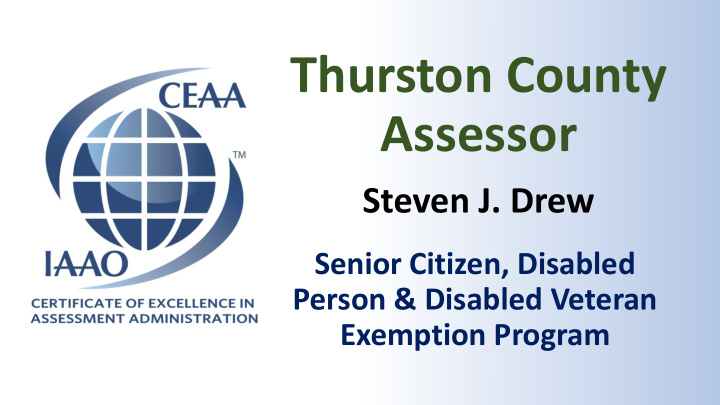



Thurston County Assessor Steven J. Drew Senior Citizen, Disabled Person & Disabled Veteran Exemption Program
Senior Exemption History • Senior Exemption law first took effect in 1967 • The program was based upon one set of three household income thresholds used for determining qualification • The dollar value thresholds were updated over the years • In 2004 the three thresholds were increased to $25,000, $30,000 and $35,000 • Program thresholds were not adjusted again until 2015 when they were increased to $30,000, $35,000 and $40,000 • In 2019 thresholds are indexed to each county’s median income • In 2020 new thresholds will be applied in 13 counties
Engrossed Substitute Senate Bill 5160 (ESSB 5160) made significant changes to the exemption program for low income senior citizens, individuals with disabilities, and veterans starting in 2020 This new law modified each of the basic qualifications for the Senior Citizen, Disabled Persons and Disabled Veterans Exemption program: • Age or Disability • Ownership and Residency • Income
• You must meet one of the following: • Age 61 by December 31 in year before the tax is due • Disabled and unable to pursue gainful employment (SSA definition) • Disabled veteran with an 80% service-connected evaluation*, or Age or receiving 100% compensation without regard to service-connected evaluation Disability • Surviving spouse or domestic partner who is at least 57 years old in year of the qualifying partner’s death and otherwise meets program requirements • * ESSB 5160 changed the service-connected evaluation from 100% to 80%
• Property must be your primary residence by December 31 st the year before the tax is due • You must occupy the residence more than 9 months each year* Ownership • May continue to qualify even if you are in a and hospital, nursing home, boarding home, Residency adult family home or home of a relative* *ESSB 5160 changed: Residency time frame from 6 months to 9 months Now allows applicants to live with a relative for the purpose of long-term care.
ESSB 5160 changes to income: • Income thresholds now tied to individual county median income if higher than previous thresholds. - Threshold 1 - 45% of median income - Threshold 2 - 55% of median income - Threshold 3 - 65% of median income • Levels to be adjusted every 5 years if median income increases • Median income for each county is determined by the Office of Financial Management Management
Counties With Threshold Change in 2020 County Income Threshold 1 Income Threshold 2 Income Threshold 3 King 40,447 49,435 58,423 Snohomish 38,591 47,167 55,743 Clark 34,856 42,602 50,348 Kitsap 33,628 41,101 48,574 Thurston 33,623 41,095 48,566 Pierce 31,644 38,676 45,708 Grant 30,929 37,802 44,675 Franklin 30,681 37,498 44,316 Chelan 30,176 36,882 43,588 Skagit 30,000 35,869 42,390 Benton 30,000 35,610 42,084 Whatcom 30,000 35,575 42,043 Kittitas 30,000 35,000 40,083 Note: In 2015 Thresholds were increased to $30,000, $35,000 & $40,000
Why do we need thresholds updated every 5 years? If you are a senior or qualifying disabled person who is truly on a fixed income this chart shows how urgently further relief was needed in counties along I-5. 2013 Median Income 2018 Median Income % Change $ Change In King County $71,122 $89,881 26% $18,759 Snohomish County $64,391 $85,758 33% $21,310 Thurston County $63,408 $74,718 18% $11,310 Pend Oreille County $42,043 $42,161 0.33% $118 If you are a senior or qualifying disabled person able to cash in savings or to otherwise supplement your income just to keep pace, the updated thresholds enable you to retain your exemption.
Income Requirements & Exemption Amounts Thurston County 2016 – 2019 Income Level New Limit Effective 2020* Exemption Description Limits Excess levies and State School Levy Part 2, plus regular levies on the first 60% of your A $30,000 or less $33,623 or less home’s value or the first $60,000, whichever *$3,623 increase in income is greater Excess levies and State School Levy Part 2, $33,624 to $41,095 plus regular levies on the first $50,000 or B $30,001 to $35,000 *$6,095 increase in income first 35% of your home’s value, whichever is greater, up to $70,000. C $35,001 to $40,000 $41,096 to $48,566 Excess levies and State School Levy Part 2 *$8,566 increase in income *ESSB 5160 changed income levels starting in 2020 tax year
How do people Sign up? • Bring income information to Assessor’s Office – Tax return with all schedules and attachments including W- 2’s, 1099’s, etc. • Assessor staff will fill out application for you and you should know if you qualify when you leave Want additional info? • Please visit your county Assessor’s website • Or call your county Assessor’s office
E2SHB 1105 Protecting taxpayers from home foreclosure • Enacts measures to protect taxpayers from home foreclosure, including requiring county Treasurers to provide: • Tax statements no later than March 15th each year • Information describing the senior citizens and disabled persons exemption and deferral property tax relief programs on each tax statement • Notification on the balance of delinquent taxes and special assessments plus interest and penalties, as well as, where the taxpayer pays his or her property taxes directly, contact information for a statewide foreclosure hotline • A homeownership resource center the name and address of delinquent tax accounts after two years of the real property taxes becoming delinquent; • A waiver for all outstanding interest and penalties on delinquent taxes for a one-time waiver when a taxpayer meets certain income -qualifications and occupy their principal place of residence.
Recommend
More recommend